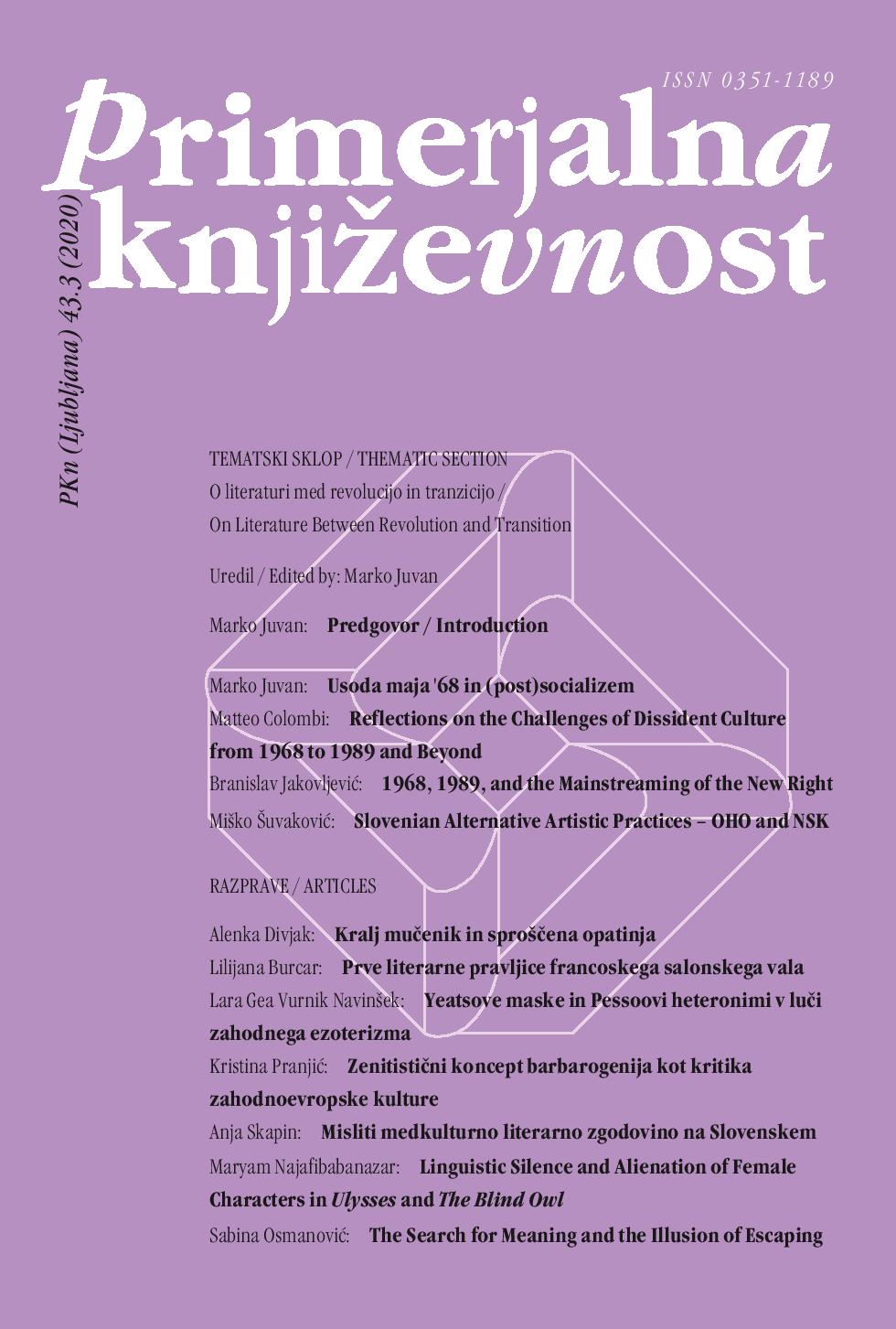The First Literary Fairy Tales of the French Salons: A Hybrid Genre
DOI:
https://doi.org/10.3986/pkn.v43.i3.06Keywords:
literary genres, romanticism, fairy tale, hybrid genre, medieval literature, novella, magicAbstract
Romantics introduced the notion that fairy tales are mere transcriptions or reworkings of folk tales, whose content they faithfully replicate. Literary history has proven otherwise: fairy tales are a hybrid literary genre that emerged out of the adaptations of basic features of two medieval and late renaissance genres, the Italian novels and medieval (knight and pastoral) romans. Narrative framing was one of the structural features French salon writers took from the Italian novella, to which they added a technique of their own. Fairy tales were preceded by dedicatory letters and introductions, and followed by afterwords and comments. These paratexts also carried literary references from earlier periods, which served as a source of inspiration for the fairy-tales’ authors. From medieval courtly romans the authors took over the archetypal settings of aristocratic courts. These were disconnected from social environment, which resulted in the creation of geo-temporal distancing and static uniformity of the fairy-tale genre. To this generic mixture, the seventeenth-century French salon authors added elements of magic, which they borrowed from classical mythology and a special type of folk tale – a wonder tale with a special focus set on fairies, heroines’ surrogate mothers.
References
Bottigheimer, Ruth. <em>Fairy Tales Framed: Early Forewords, Afterwords, and Critical Words</em>. Albany: SUNY Press, 2012.
Bottigheimer, Ruth. »Fairy Tales«. <em>Encylopedia of German Literature</em>. Ur. Matthias Konzett. Chicago: Fitzroy Dearborn, 1999. 267–270.
Bottigheimer, Ruth. <em>Fairy Tales: A New History</em>. Albany: SUNY Press, 2009.
Brocklebank, Lisa. »Rebellious Voices: The Unofficial Discourse of Cross-dressing in d’Aulnoy, de Murat, and Perrault«. <em>Children’s Literature Association Quaterly</em> 25.3 (2000): 127–136.
Cheira, Alexandra. »A Fairy Godmother of Her Own 17th Century France: Subversive Female Agency in Madame d’Aulnoy’s ‘The White Cat‘«. <em>Anglo Saxonica</em> 30.8 (2014): 219–240.
Duggan, Anne E. »Conte des feés«. <em>Folktales and Fairy Tales: Traditions and Texts from around the World</em>. Ur. Ann E. Duggan idr. Santa Barbara; Denver: Greenwood, 2016. 234.
Fatur, Silvo. <em>Književnost II</em>. Maribor: Obzorja, 1982.
Feat, Anne-Marie. »Playing the Game of Frivolity: Seventeenth-Century <em>Conteuses</em> and the Transformation of Female Identity«. <em>Journal of the Midwest Modern Language Association</em> 45.2 (2012): 217–242.
Grimm, Jacob, in Wilhelm Grimm. »Vorrede«. <em>Deutsche Sagen</em>. Berlin: in der Nicolaschen Buchhandlung, 1816. v–xxvi.
Haase, Donald. <em>The Reception of Grimms’ Fairy Tales: Responses, Reactions, Revisions</em>. Detroit: Wayne State University Press, 1993.
Haase, Donald. »Yours, Mine, or Ours? Perrault, the Brothers Grimm, and the Ownership of Fairy Tales«. <em>Merveilles & contes</em> 7.2 (1993): 383–402.
Hannon, Patricia, in Anne E. Duggan. »French Tales: Origins of the French Tale Tradition«. <em>The Greenwood Encyclopedia of Folktales and Fairy Tales</em>. Ur. Donald Hasse. Westport; London: Greenwood Press, 2008. 379–388.
Jasmin, Nadine. »Sophistication and Modernization of the Fairy Tale«. <em>Teller’s Tale: The Lives of the Classic Fairy Tale Writers</em>. Ur. Sophie Raynard. Albany: SUNY Press, 2012. 41–46.
Jones, A. Christine. »Madame d’Aulnoy Charms the British«. <em>The Romanic Review</em> 99.3/4 (2008): 239–256.
Kos, Janko. <em>Književnost: učbenik literarne zgodovine in teorije</em>. Maribor: Obzorja, 1989.
Lee M., Roberts. <em>Literary Nationalism in German and Japanese Germanistik</em>. Berkley Insights into Linguistics and Semiotics 78. New York: Peter Lang, 2010.
Patard, Geneviéve. »Henriette-Julie de Castelnau, Countess de Murat«. <em>Teller’s Tale: The Lives of the Classic Fairy Tale Writers</em>. Ur. Sophie Raynard. Albany: SUNY Press, 2012. 81–87.
Perrault, Charles. »Preface«. <em>Fairy Tales Framed: Early Forewords, Afterwords, and Critical Words</em>. Ur. Ruth Bottigheimer. Albany: SUNY Press, 2012. 114–118.
Perrault, Charles. »Dedicatory Letter to Mademoiselle (1695)«. <em>Fairy Tales Framed: Early Forewords, Afterwords, and Critical Words</em>. Ur. Ruth Bottigheimer. Albany: SUNY Press, 2012. 126.
Saupé, Yvette, in Jean-Pierre Collinet. »Charles Perrault«. <em>Teller’s Tale: The Lives of the Classic Fairy Tale Writers</em>. Ur. Sophie Raynard. Albany: SUNY Press, 2012. 47–59.
Seifert, C. Lewis. »Marie-Jeanne Lhéritier de Villandon«. <em>Teller’s Tale: The Lives of the Classic Fairy Tale Writers</em>. Ur. Sophie Raynard. New York: Suny Press, 2012. 75–80.
Seifert, Lewis. <em>Fairy Tales, Sexuality, and Gender in France, 1690–1715: Nostalgic Utopias</em>. Cambridge; New York: Cambridge University Press, 1996.
Snyder, Louis L. »Cultural Nationalism: The Grimm Brothers’ Fairy Tales«. <em>Roots of German Nationalism</em>. Ur. Louis L. Snyder. Bloomington: Indiana University Press, 1978. 35–54.
Snyder, Louis L. »Nationalistic Aspects of the Grimm Brothers’ Fairy Tales«. <em>The Journal of Social Psychology</em> 33 (1951): 209–223.
Tartar, Maria. <em>Off with their Heads: Fairy Tales and the Culture of Childhood</em>. Princeton: Princeton University Press, 1992.
Thelander, R. Dorothy. »Mother Goose and Her Goslings: The France of Louis XIV as Seen through the Fairy Tale«. <em>The Journal of Modern History</em> 54.3 (1982): 467–496.
Touttain, Piere-André. »O pravljicah Mme. d’Aulnoy«. <em>Pavji kralj in druge pravljice</em>. Madame d’Aulnoy. Ljubljana: Mladinska knjiga, 1987. 6–7.
Treverson, Andrew. <em>Fairy Tale</em>. London; New York: Routledge, 2013.
Welch, Ellen. »‘Une feé moderne’: An Unpublished Fairy Tale by la Comtesse de Murat«. <em>Eighteenth-Century Fiction</em> 18.4 (2006): 1–20.
Zipes, Jack. »The Rise of the French Fairy Tale and the Decline of France«. <em>Beauties, Beasts, and Enchantment: Classic French Fairy Tales</em>. Ur. Jack Zipes. Maidstone: Crescent Moon Publishing, 2009. 1–13.
Zipes, Jack. <em>Breaking the Magic Spell: Radical Theories of Folk and Fairy Tales</em>. Lexington: University Press of Kentucky, 2002.
Zipes, Jack. <em>When Dreams Came True: Classical Fairy Tales and Their Tradition</em>. New York; Abingdon: Routledge, 2007.
Zipes, Jack. <em>The Great Fairy Tale: From Straparola and Basile to the Brothers Grimm</em>. New York: Norton Critical Edition, 2001.
Zipes, Jack. <em>The Trials and Tribulations of Little Red Riding Hood: Versions of the Tale in Sociocultural Context</em>. New York; Oxon: Routledge, 1993.
Zipes, Jack. »Media-hyping of fairy tales«. <em>The Cambridge Companion to Fairy Tales</em>. Ur. Maria Tatar. Cambridge: Cambridge University Press, 2015.
Warner, Marina. <em>From the Beast to the Blonde: On Fairy Tales and Their Tellers</em>. London: Vintage, 1995.


